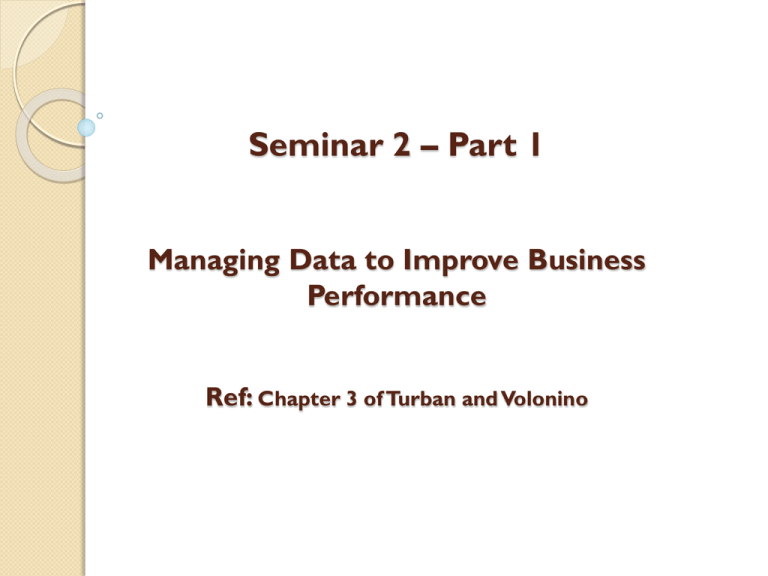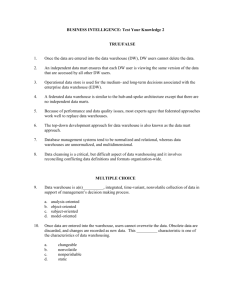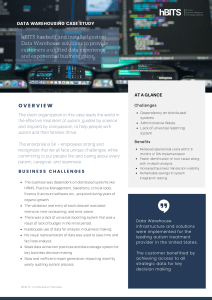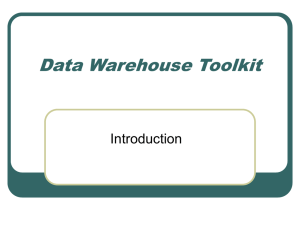Seminar_2_-_CHP_3
advertisement

Seminar 2 – Part 1 Managing Data to Improve Business Performance Ref: Chapter 3 of Turban and Volonino Learning Objectives 1. 2. 3. 4. 5. Describe how data and document management impact profits and performance. Understand how managers are supported or constrained by data quality. Discuss the functions of databases and database management systems. Understand how logical views of data provide a customized support and improve data security. Describe the tactical and strategic benefits of data warehouses, data marts, and data centers. Learning Objectives cont’d 6. Describe transaction and analytic processing systems. 7. Explain how enterprise content management and electronic records management reduce cost, support business operations, and help companies meet their regulatory and legal requirements. Applebee’s International Learns & Earns Problem: Huge quantities of data in many Databases. Solution: Enterprise data warehouse implemented. Results: Improved profitability. Applebee’s enterprise data warehouse and feedback loop. Data, Master Data, and Document Management Data management is crucial for productivity of managers and employees Data – Organisations key asset Data decisions high quality data High Quality Data how data is managed Data life cycle Data Management – a structured approach to managing data. ◦ Principles of Diminishing Value, ◦ 90/90 Rule, and ◦ Principles of data in context. Analyzing Any Business Business analytics Data Visualization Dow Jones industrial average (DJIA) for a single day in tabular display and graphical display. MDM – Master Data Management Master Data Management (MDM) – integrating to provide a more unified view of data Operational versus Analytical Master Data Management Demystifying Master Data Management Would You Like Fries With That? And Does CrossSelling Justify Master Data Management? Data management's top eight stories of 2008 Human resources data analytics brings metrics to workforce management Master Data Entities Main entities of company ◦ Customers ◦ Suppliers ◦ Employees Different Master Data needs Model of an enterprise data warehouse. Data Quality Data’s usefulness Quality of the decision based on the data ◦ ◦ ◦ ◦ ◦ Accuracy Accessibility Data Quality Example Relevance vs. Reliability Timeliness Completeness Document Management Effective business continuity planning requires the timely restoration of critical functions after a disruption to normal business operations. This would include developing plans for recovery of essential IT infrastructure, critical applications, and time sensitive business processes. In the aftermath of emergency situations, however, it is all too common to find that organizations fail to plan adequately to protect and replicate paper records, as necessary to mitigate risk and continue operations. Document Management Implementation of any record management and/or paper digitization solution is a significant undertaking and must be approached with a detailed plan of action and significant buy-in and approval from all stakeholders. Implementation breaks down into 4 distinct phases: Identifying objectives Identifying products that meet those objectives Implementing a system Digitization of records File Management Systems Example of primary and foreign keys. Hierarchy of data for a computerbased file. A file Management Approach Computer-based files of this type cause problems such as redundancy, inconsistency, and data isolation. Database and Database Management Systems DBMS Data Access – An integrated Approach Database management system provides access to all data in the database. Data Warehouse, Marts and Centers Data warehouse framework and views. Electronic records management from creation to retention or destruction. Content Management ERM Vendors – check these out! ACCUTRAC® SOFTWARE Managerial Issues Reducing uncertainty. Cost-benefit issues & justification. Where to store data physically. Legal issues. Internal or external collection, storage, maintenance, & purging of databases of information. Disaster recovery. Data security & ethics. Privacy. Legacy systems. Data delivery.











